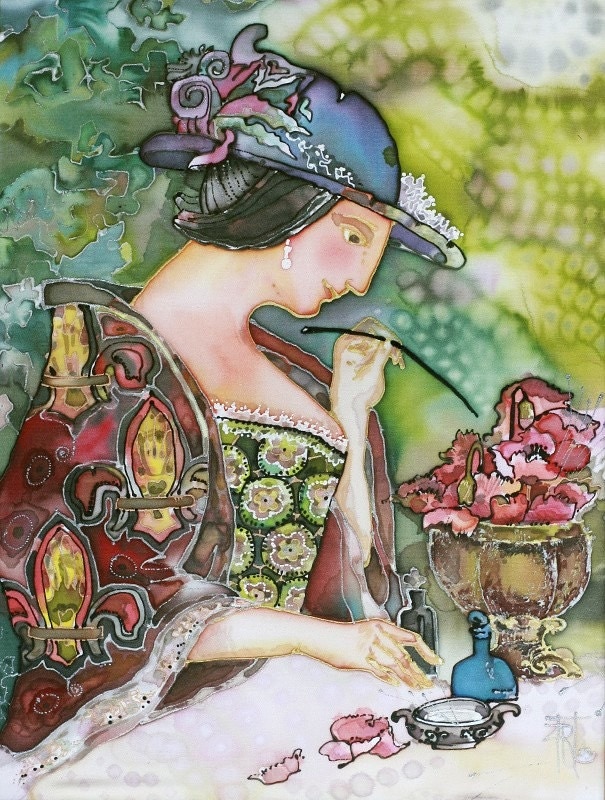Give Your loved one a Hand Painted Silk Scarf. You Will Brighten Up her day!
Properties and Characteristics of Silk
Cultivated silk from the Bombyx mori silkworm, which is and has always been the most common type of silk used, has a number of interesting and desirable properties that have been admired for over 5,000 years.
First of all, silk takes well to dyes, both natural and synthetic, which results in colorful fabrics. Another property of silk is its soft feel, and it retains it shape well, even after having been stretched. In appearance silk has a sheen and luminosity that makes it look luxurious. Since silk production is labor intensive and costly it has often been used by royalty and people of wealth for centuries, and it has in fact sometimes become a
symbol for wealth and achievement. In England, for example, when an attorney reaches a certain status and earns the honor of being a QC (for Queen’s Council), he or she is said to “take the silk”. From then on they will wear a silk gown during court proceedings. In fact silk dresses from pure English silk are normally worn in royal weddings in England, and this is a tradition that has been upheld for centuries. There are still small silk making operations located there in modern times.
Silk has the property of being a very flexible material. For example, a silk scarf can readily be pulled through a wedding ring, and it will quickly retake its original shape without a lot of wrinkling. It is light in weight, and it can be easily folded. Silk scarves are excellent for women who travel, as a lady can change her look by changing scarves and can get away with carrying fewer outfits than she normally might wear at home. In addition, silk tends to fall naturally and hangs delicately when used as clothing. This gives it an appeal over other fabrics that are more stiff and rigid. In addition, silk holds its structural integrity and will not rot. Silk is also more heat resistant than many other fabrics, including wool, for example, and is actually rather difficult to burn.
One remarkable property of silk is its high tensile strength and its fibers will not easily be torn or damaged. It is also an elastic material that can be stretched and then will recover to its original size unless stretched beyond 20-25% of its original length. It has been used in the past in making guy ropes to take advantage of this characteristics.
Silk clothing keeps one cool in the summer, and it provides surprising warmth in the winter and is often used as an insulation layer in different types of clothing or even in sleeping bags. Silk can absorb a fairly significant amount of moisture before it feels wet.
Silk can be woven together with other fabrics in blends, and it is most often used in articles of clothing such as dresses, pants, sweaters, gowns, and shirts, for example. Silk ties for men have a look and feel that is exceptional, and many men prefer silk ties and use them almost exclusively.
For all these reasons silk has been desired for centuries. The secrets of its production were held tightly in China for over 2,000 years, but finally the knowledge and raw materials (silkworms and mulberry trees) were to be found elsewhere in the world, and many countries had a significant number of people employed in the production of silk goods. China is today the world leader in silk production, just as it was several thousand years ago. China produces over half the world’s silk, and India accounts for about a quarter of the Chinese production. India is, however, the leader in production of wild silks, that is, silk spun from species of silkworms other than B. mori which live in the wild, such as the tussah silkmoth. Silk production from these wild silkworms is much less predictable and much more difficult to control, since these insects cannot be domesticated like the B. mori. Furthermore, tussah silk is said to be somewhat more coarse than silk from B. mori. Despite the arrival of less costly synthetic fabrics like rayon and nylon, the properties and characteristics of silk account for its continued significant demand.
Painter by silkstory on Etsy

Very interesting. I didn;t know silk can cool in summer and make warm in winter :) Thank you for this post!
ReplyDeleteHappy HOlidays dear Zita! I love collecting your scarves!
ReplyDelete